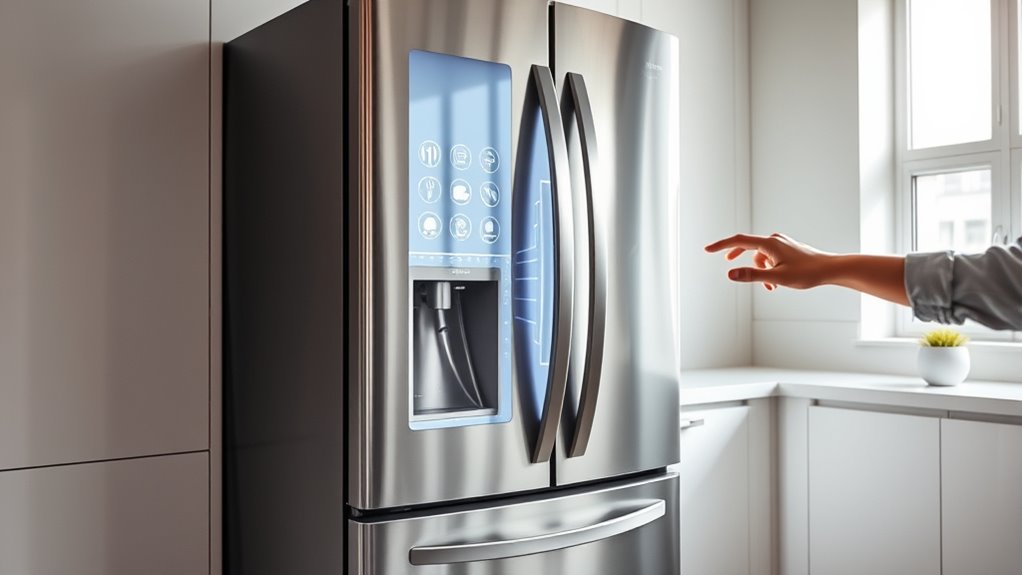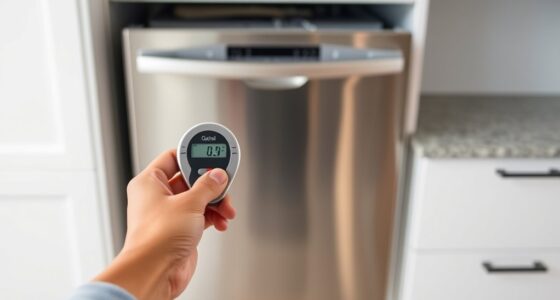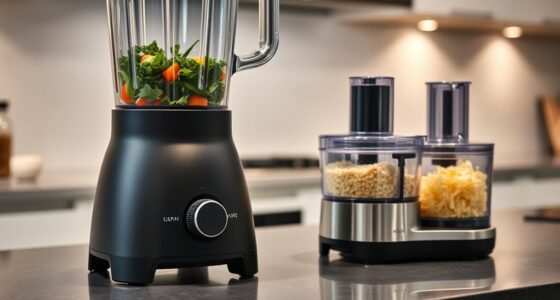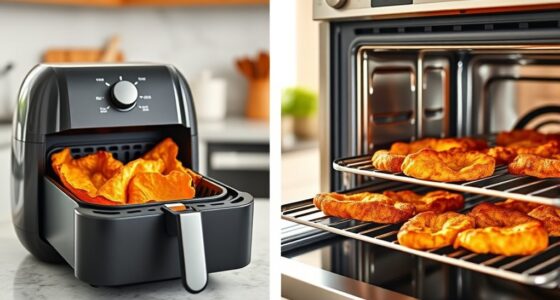Touchscreens on smart refrigerators can make your kitchen more convenient by allowing you to check inventory, browse recipes, or control settings easily. However, whether you truly need them depends on your lifestyle and whether you value tech-savvy features. These screens can improve daily routines but might add to maintenance costs and potential repairs. To discover if this innovation fits your needs, explore the benefits and drawbacks in more detail.
Key Takeaways
- Touchscreens enhance convenience for inventory management, recipe browsing, and list creation, but are optional for basic fridge functions.
- They increase repair costs and potential technical issues, which may outweigh their practical benefits.
- Digital features like remote control and alerts improve energy efficiency and maintenance, but not everyone needs these capabilities.
- The necessity of a touchscreen depends on individual lifestyle and preference for tech integration versus simplicity.
- Basic models without touchscreens often provide similar core functionalities at lower cost and maintenance.

Have you ever wondered how your refrigerator could become smarter? Modern smart refrigerators pack a lot of features, including touchscreens, Wi-Fi connectivity, and even cameras inside. But do you really need all these high-tech additions? One of the biggest benefits of smart refrigerators is their potential for improving energy efficiency. These models often come with advanced sensors and algorithms that optimize cooling cycles, reducing unnecessary power consumption. By adjusting compressor operation based on usage patterns and external conditions, a smart fridge can help you save on energy bills over time. This focus on efficiency not only benefits your wallet but also contributes to a more sustainable household. Additionally, some models incorporate emotional support features, such as reminders for medication or family schedules, which can add value to your daily routines. However, it’s important to weigh how these features might impact maintenance costs. While a traditional refrigerator might require only occasional repairs or part replacements, smart models with their complex electronics and digital components can be more costly to maintain. If the touchscreen or Wi-Fi modules malfunction, repairs might involve replacing expensive parts or even entire panels. Additionally, software updates or troubleshooting might necessitate professional service, adding to the overall maintenance costs.
On the flip side, some smart refrigerators can alert you to potential issues before they become serious, such as notifying you of temperature fluctuations or door openings, which can help you address problems early and avoid costly repairs. These proactive features could offset some of the higher maintenance costs in the long run. Still, you should evaluate whether the added expense and complexity align with your household’s needs and budget. If you’re someone who values convenience and cutting-edge technology, the touchscreen interface offers a lot of benefits. You can check inventory, create shopping lists, or even browse recipes right on your fridge without needing separate devices. But if you’re more practical and prefer simplicity, a basic model might serve you just as well without the extra expense. It’s worth contemplating whether the digital features enhance your daily routine or if they’re just flashy extras. In the end, smart refrigerators can bring significant advantages, especially in terms of energy efficiency, but they also come with higher maintenance costs and potential technical issues. Whether you really need a touchscreen on your fridge depends on your lifestyle, budget, and how much you value the convenience of digital integration.
Frequently Asked Questions
Are Smart Refrigerators Energy-Efficient Compared to Traditional Models?
Smart refrigerators often have higher energy consumption because of their advanced features, but many models are designed to be eco-friendly. You might find that they use less power thanks to energy-efficient components and smart technology that optimizes operation. While they can be more energy-efficient than older, traditional models, it’s best to compare specific features to determine if they suit your eco-friendliness goals and reduce overall energy consumption.
How Secure Are Smart Refrigerators Against Hacking and Data Breaches?
Did you know that 68% of IoT device users worry about cybersecurity vulnerabilities? Smart refrigerators face privacy risks and hacking threats, making security a real concern. You should be aware that weak passwords or outdated software can expose your data. While manufacturers improve security, it is crucial to stay vigilant, update firmware regularly, and use strong, unique passwords to protect your devices from potential breaches.
Can Smart Refrigerators Be Integrated With Existing Smart Home Systems?
You can definitely integrate your smart refrigerator with existing smart home systems, but beware of compatibility issues. Not all brands or models sync seamlessly, so check compatibility beforehand. You’ll need to guarantee your fridge supports smart home integration protocols like Zigbee or Z-Wave. Once connected, you can control settings via your smart home hub or app, making your kitchen more efficient and interconnected. Just verify compatibility to avoid frustration.
What Is the Typical Lifespan of a Touchscreen on a Smart Fridge?
Did you know touchscreen durability concerns mean they typically last about 3 to 5 years? You might find yourself replacing or repairing the screen sooner due to scratches or malfunctions. Regular touchscreen maintenance can extend its life, but active use and exposure to moisture or dust still pose risks. If longevity matters, you might prefer traditional controls, as touchscreens tend to wear out faster than other fridge components.
Are There Any Health Concerns Related to Touchscreen Usage on Refrigerators?
You might wonder about touchscreen germ concerns on your fridge. While touchscreens can harbor bacteria, regular hygiene maintenance, like wiping with disinfectant, minimizes health risks. Simple cleaning routines help reduce germs and keep your appliance hygienic. So, if you stay diligent with touchscreen cleaning, you can enjoy the convenience without worrying too much about hygiene. Proper maintenance guarantees your fridge remains a safe, user-friendly part of your kitchen.
Conclusion
So, next time you walk by a smart fridge with a touchscreen, ask yourself if it’s truly necessary. Maybe you’ll find that the convenience it promises isn’t worth the extra cost or complexity. Sometimes, it’s the simple things—like a good old-fashioned handle—that keep life straightforward. After all, just like the chance encounter with a friend who reminds you of what really matters, a basic fridge might be all you need for everyday life.









